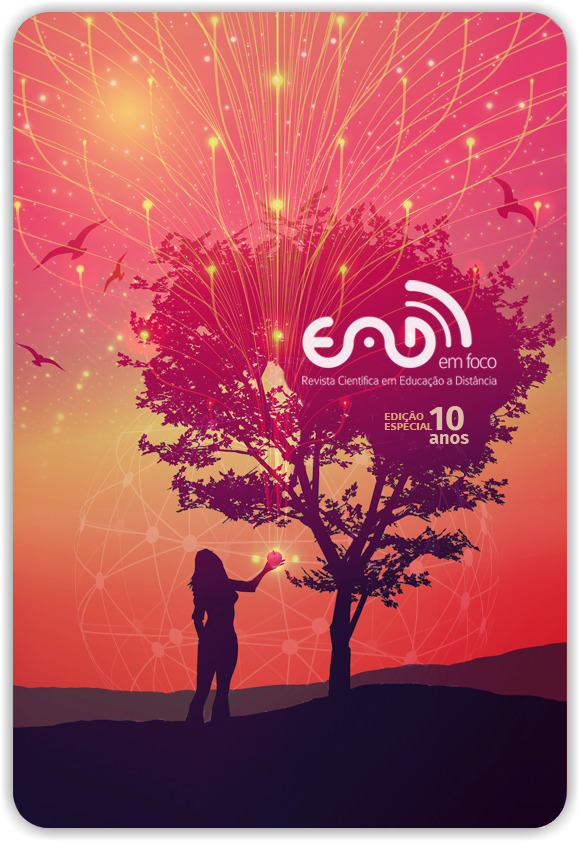New Technologies Applied in Distance Education: a Case Study on Retention and Dropout in Higher Education
DOI:
https://doi.org/10.18264/eadf.v10i2.919Abstract
In an increasingly globalized world, based not only on costs and innovation, where speed is now critical to success in the market, professionals must always be prepared for the challenges of change, creativity and revolution of knowledge. New technologies associated with distance education projects increase the possibility of access to a professional training program. Even with the increasing technological advancement in distance learning, it was not efficient to contain the evasion number. Working distance education is not simple, and a teaching methodology is needed in synergy with the navigation tools, simple to be absorbed by the students and that will create an interaction between teachers and students who are the great actors of education. The study aims to know the main factors that contribute to distance learning avoidance and present strategies in its control. It is concluded that the avoidance control should be well planned from the preparation of the course, with permanent communication, a good infrastructure in the technology part so that the student can follow the course and have control over the software that will use it, in order to provide support in the technological and pedagogical issues..
Keywords: Knowledge. Evasion. Training.
Downloads
References
ALMEIDA, O. C. S. Evasão em cursos í Distância: análise dos motivos de desistência. Congresso da ABED. p.1-10. 2008. Disponível em <http://www.abed.org.br/congresso2008/tc/552008112738PM.pdf> Acesso em 03 de novembro de 2019.
ALVES, L.; Um olhar pedagógico das interfaces do Moodle. In: Lynn; Barros, Daniela; Okada, Alexandra (Org.). MOODLE : Estratégias Pedagógicas e Estudos de Caso. Salvador: Eduneb, p 187-201. 2009
BEHAR, P. A. Modelos Pedagógicos em Educação a Distância. Porto Alegre: Artmed, 2009.
BITTENCOURT, I. M.; MERCADO, L. P. L. Evasão nos cursos na modalidade de educação a distância: estudo de caso do Curso Piloto de Administração da UFAL/UAB. Ensaio: aval.pol.públ.Educ., Rio de Janeiro , v. 22, n. 83, p. 465-504, Junho 2014.Disponível em <http://www.scielo.br/scielo.php?script=sci_abstract&pid=S0104-40362014000200009&lng=en&nrm=iso&tlng=pt>. Acesso em 03 de novembro de 2019.
COMARELLA, R. L. Educação superior a distância: evasão discente – Programa de Pós-Graduação em Engenharia e Gestão do Conhecimento, Universidade Federal de Santa Catarina, Florianópolis, 147 p. Dissertação (Mestrado). 2009. Disponível em <https://repositorio.ufsc.br/handle/123456789/93392>. Acesso em 03 de novembro de 2019.
COSTA, M. L. F.; OLIVEIRA, S. A. G. DE. O lugar da Educação a Distância no Plano Nacional de Educação (2011-2020). Teoria e Prática da Educação, v. 16, n. 1, p. 97-112, 5 maio 2013.Disponível em: <http://periodicos.uem.br/ojs/index.php/TeorPratEduc/article/view/23766>. Acesso em 03 de novembro de 2019.
COSTA, I. Novas tecnologias e aprendizagem. 2a. ed. Rio de Janeiro: Wak Editora. 2014
DUARTE, G. P. As funções do tutor online [manuscrito]: análise da interatividade tutor/aluno no projeto piloto do curso de administração de empresas da Universidade Federal do Piauí. Dissertação de Mestrado. Brasília: Faculdade de Educação da Universidade de Brasília, 2008. Disponível em <http://repositorio.unb.br/bitstream/10482/3506/1/2008_GilmarPereiraDuarte.pdf.> Acesso em 3 de novemnro de 2019.
GIL, A. C. Como elaborar projetos de pesquisa. 5. ed. São Paulo: Atlas, 2010.
INSTITUTO NACIONAL DE ESTUDOS E PESQUISAS EDUCACIONAIS ANíSIO TEIXEIRA. Censo da Educação Superior 2018. Brasília: MEC/INEP, 2019.
_________________________. Censo da Educação Superior 2017. Brasília: MEC/INEP, 2018.
_________________________. Censo da Educação Superior 2016. Brasília: MEC/INEP, 2017.
LAKATOS, E. M.; MARCONI, M. A. Metodologia científica: Ciência e conhecimento científico. Métodos científicos. Teoria, hipóteses e variáveis. Metodologia jurídica. 6a ed. São Paulo: Atlas. 2011
MAIA, C.; MATTAR, J. ABC da EaD: a Educação a Distância hoje. São Paulo: Pearson, 2007.
MALUF, R. A evasão escolar e o ensino a distância. ABED. 2012
MATTAR, J. Interatividade e aprendizagem. In: LITTO, F. M.; FORMIGA, M. (Org). Educação a distância: o estado da arte. São Paulo: Pearson, 2009.
MOORE, M.; KEARSLEY, G. Educação a distância: uma visão integrada. São Paulo: Cengage Learning.2010.
SANTOS, G. L. A internet na escola fundamental: sondagem de modos de uso por professores. Educ. Pesqui., São Paulo , v. 29, n. 2, p. 303-312, Dec. 2003
SILVA FILHO, R. L. L. A evasão no ensino superior brasileiro. Cad. Pesqui., São Paulo , v. 37, n. 132, p. 641-659, Dec. 2007
SOUZA, C.; DA SILVA, C.; GESSINGER, R. Um estudo sobre evasao no ensino superior do Brasil nos últimos dez anos. II Congressos CLABES, 9 out. 2017.
Downloads
Published
How to Cite
Issue
Section
License
Copyright (c) 2020 EAD EM FOCO

This work is licensed under a Creative Commons Attribution 4.0 International License.
All articles published in Revista EaD em Foco receive the license
Creative Commons - Atribuição 4.0 Internacional (CC BY 4.0).
All subsequent publications, complete or partial, must be made with the acknowledgment, in citations, of the Revista EaD em Foco as the original editor of the article.













